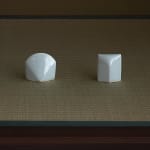Suzuki Osamu (1926−2001)
Tarō and Hanako
Sealed “Su” on the back (each)
With a box signed by the artist (each)
Taro: L3.4 x W6.2 x H7.2 cm
Hanako: L3.1 x W8 x H7.5 cm
Further images
-
(View a larger image of thumbnail 1
)

-
(View a larger image of thumbnail 2
)

-
(View a larger image of thumbnail 3
)

-
(View a larger image of thumbnail 4
)

-
(View a larger image of thumbnail 5
)

-
(View a larger image of thumbnail 6
)

-
(View a larger image of thumbnail 7
)

-
(View a larger image of thumbnail 8
)

Taro and Hanako are the most typical Japanese names of boy and girl respectively. Taro is shaped by a ridge line rising up from the lower center, which gradually sweeps toward the straight upper side; Hanako features an arched top and two ridge lines stretching to the lower center and joining together. The pair of the palm-sized works is applied on the pale blue glaze, bearing a title signed Little Clay Image: One of Taro and Hanako by the artist on each box, indicating that they come from the series of Little Clay Images originated by Suzuki Osamu.
Titles of the works in this series are mostly inspired by natural subjects such as the wind or sun; yet this pair is designated as a man and a woman with strong cultural connotation. Suzuki’s Taro and Hanako are an embodiment of masculine and feminine, and a symbol of two complementary principles. They could be, for example, displayed as the hina dolls at the dolls’ festival in March. This is because the shape and the human-like names interplay each other that fascinates the viewer when considered in the context of the traditional culture. The fundamental idea that the meaning of creation must be transcended from simply a vessel or a pure sculpture, to one bearing its own interpretation is what Suzuki Osamu strives to pursue in his artistic making throughout his career.
Suzuki Osamu (ceramist; 1926−2001)
Kyoto-born ceramist. Established an avant-garde ceramist group Sodei-sha with Yagi Kazuo, Yamada Hikaru, and others. Played an innovative role and breathed fresh air into Japan’s contemporary ceramic field. Received awards from the Japan Ceramic Society, Asahi Ceramic Art Exhibition, and many others in and out of Japan. Appointed Kyoto City University of the Arts professor.
Titles of the works in this series are mostly inspired by natural subjects such as the wind or sun; yet this pair is designated as a man and a woman with strong cultural connotation. Suzuki’s Taro and Hanako are an embodiment of masculine and feminine, and a symbol of two complementary principles. They could be, for example, displayed as the hina dolls at the dolls’ festival in March. This is because the shape and the human-like names interplay each other that fascinates the viewer when considered in the context of the traditional culture. The fundamental idea that the meaning of creation must be transcended from simply a vessel or a pure sculpture, to one bearing its own interpretation is what Suzuki Osamu strives to pursue in his artistic making throughout his career.
Suzuki Osamu (ceramist; 1926−2001)
Kyoto-born ceramist. Established an avant-garde ceramist group Sodei-sha with Yagi Kazuo, Yamada Hikaru, and others. Played an innovative role and breathed fresh air into Japan’s contemporary ceramic field. Received awards from the Japan Ceramic Society, Asahi Ceramic Art Exhibition, and many others in and out of Japan. Appointed Kyoto City University of the Arts professor.







